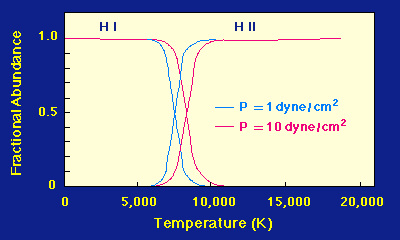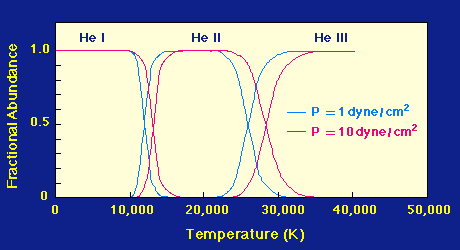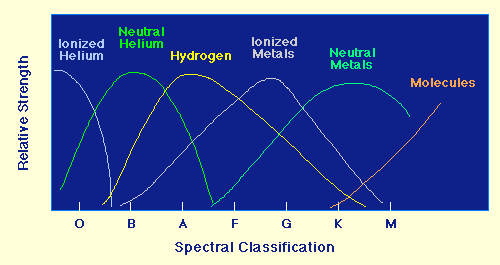| |
The Spectral Sequence as a
Temperature Sequence
|
At first the Harvard Spectral Sequence
was thought to reflect different compositions for different stars.
We now know that the different spectral types are primarily a consequence of
different surface temperatures for the stars, with composition differences playing
only a minor role.
Ionization and Surface Temperature
The key to understanding stellar spectra is that the degree of ionization for
various atoms depends strongly on the temperature and weakly on the density, as
illustrated in the following image for hydrogen
 |
|
Ionization of Hydrogen
|
and in this image for helium:
 |
|
Ionization of Helium
|
From these diagrams we conclude that
-
The higher the temperature, the more likely that higher states of ionization are
produced. For example, we see that at a temperature of 5000 K almost all hydrogen
is present as neutral hydrogen (H I), but at 10,000 K almost all hydrogen is in
the form of ions (H II).
-
Since the spectrum of an ion is generally different than the spectrum of the
corresponding atom, what lines appear in the spectrum will depend strongly on the
temperature. For example, the above figures indicate that neutral hydrogen lines
would be present at a temperature of 5000 K, but almost absent at 15,000 K.
-
Helium requires higher temperatures to ionize than hydrogen.
-
There is a weak but not zero dependence of the degree of ionization on the
pressure (and hence the density) at a given temperature.
Interpretation of the Harvard Spectral Sequence
Thus, we may interpret the Harvard Spectral Sequence as primarily a temperature
sequence. The following diagram illustrates, giving qualitatively the dominant
spectral lines for different spectral classes.
 |
|
Ionization vs. Spectral Class
|
For example, a dominant characteristic of spectral class A stars is the presence
of strong hydrogen lines, but ionized helium lines are only present in the class O
stars. As noted above, since helium ionizes only at high temperatures, this
tells us that class O stars must have very high surface temperatures. On the
other hand, spectral lines associated with molecules are only found for spectral
classes K and M. This is because these correspond to low surface temperatures,
and molecules can only hold together in stars with relatively low surface
temperatures.
Spectral Class and Surface Temperature
Generally, the above sequence is a surface
temperature sequence, with high temperatures
toward the left (O and B stars) and low temperatures to the right (K and M stars).
Since the color index is also a measure of surface temperature, this sequence may
also be interpreted in terms of color index, with algebraically smaller values of
the color index to the left and larger values to the right.



